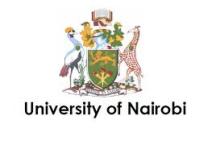Resource information
Few studies exist that show the relationship between urban transportation and urban structure in the developing world. As the developing countries become rapidly urbanized, there is growing need for adequate planning for a balanced urban development. Urban planners should pay attention to urban transportation for it provides access to urban areas and helps to reduce intra-urban inequality.
The present study examines the relationship between urban transport and urban structure at a micro-scale that is on urban area in Kenya. The study covers the Mombasa municipal area. The study investigates the relationship between time-distance and land values, population density and travel patterns or the number of personal trips.
In many applications, the linear distance has given way to the more revealing features of time-distance. Travel time is always more relevant in the developing countries than physical or road distances. Transport improvements in the developing countries often proceed rapidly with a correspondingly rapid impact on the structure of the space economy.
This study raises and examines three questions. They are:
1. What is the structure of land values, population density and personal trips within the Mombasa Municipal area?
2. To what extent does the transportation pattern influence the structure of land values, population density and personal trips within the Mombasa Municipal area?
3. Is the structure observed similar or different from that in industrialized cities?
Mombasa is both a pre-industrial as well as a colonial city. Therefore it offers an appropriate testing ground for the theories and findings on the urban transportation expansion and its relationship to urban structure. This study attempts to achieve three objectives:-
a) Establishing the relationship between time-distance and land values.
b) Establishing the relationship between time-distance and population density.
c) Establishing the relationship between time-distance and the number of personal trips to the city centre.
Three hypotheses are advanced and their validities tested. They are:
a) Land values decline with increasing travel time from the city centre. An inverse relationship exists between time-distance and land values.
b) Population density declines with increasing travel time from the city centre. An inverse relationship exists between travel time and population density.
c) The number of personal trips decreases with increasing travel time from the city centre. An inverse relationship exists between time-distance and the number of personal trips to the city centre.
The hypotheses are tested by means of; the description and explanation of the structure of land values, population density and trips, bivariate regression on land values, density and trips as well as the mapping of regression residuals.
Time-distance is measured from Mwembe Tayarl on the Mombasa Island using Municipal Bus time. A partial correlation analysis is used to measure the relationship between bus time and the three dependent variables holding matatu time constant.
The study is limited to a time-distance analysis for bus and Matatu travel time. It excludes other transport modes such as air, rail and sea transport. These areas can be explored in future research. The study comprises seven Chapters. The first Chapter is the Introduction which explains the problem to be investigated and includes a Literature Review.
The Second Chapter deals with research Methodology and describes the techniques used to test the hypotheses and their limitations.
Chapter 3 deals with the spatial structure of the road network in Mombasa. This examines the main road network including bridges, causeways and ferries. It also examines the main forms of public transport, that is the bus and matatu systems.
Chapter 4, 5 and 6 deal with the structure and the factors influencing land values, population density an travel patterns in Mombasa respectively. Chapter 7 is the summary and concluding chapter. Here the main research findings are mentioned, recommendations and conclusions are also made. The main findings of this study are:
Land values, population density and the number of home-based trips decline, with time-distance from the city centre and are relatively higher on the Mombasa Island than on the mainland. This is mainly because of the good road network on the Island providing a high degree of accessibility. The Kenya Bus Travel time has a generally higher person correlation coefficient with land values, population density and trips than the matatu time.
The land value theory, population density functions and travel patterns developed in the Western countries apply to Mombasa to some extent. But, this does not mean that urban transportation and urban structure in the developing world should be modeled after the Western city without modifications. This study attempts to show how urban transportation influences urban structure and therefore, provides a case for using transportation as a tool for structuring of Third World cities to benefit a majority of the residents.


